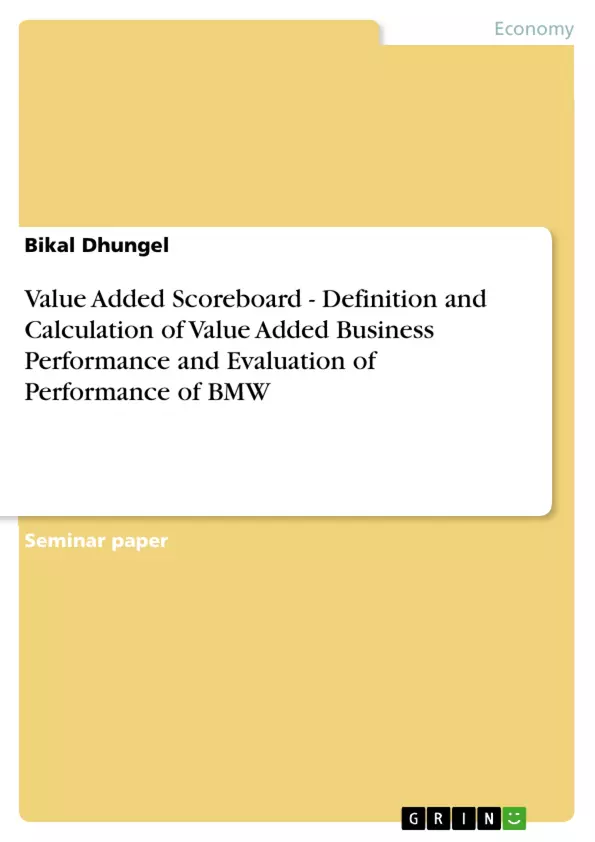According to BIS ( Department for Business innovation and skills ), Value Added measures the amount of wealth created by a company and is of particular importance since it reflects the ability of companies to provide their customers with what they want and are prepared to pay for. As such, it provides a broader perspective on a company‟s economic contribution than operating profit. Mathematically, Value Added = Company Sales – Bought-in goods.
Value added is regarded as one of the most important objective of a Firm or a company because it measures the amount of the wealth created by a company, from where we can analyze how a particular company is contributing to the economy of a certain country. Every year the „Value Added Scoreboard‟ measures the overall growth of a company and examines the efficiencies. The analysis will be in many different sectors, sometimes differentiated by a country or a region which we will talk in this paper later. The British Minister of State for Science and innovation Lord Paul Drayson mentioned in his ministerial foreword that innovation is essential to national competitiveness and to ensure that countries can respond to global challenges and opportunities. He also mentions the clear ambition of British government to make the UK the best place to do business. Chancellor of the Exchequer Mr. Alistair Darling mentioned his support to innovative businesses in the UK. Many people believe that the coming century will be an Asian century with Asia contributing one third of the global GDP. This is also a good reason to make the UK and Europe most welcoming place for businesses and especially innovative businesses. As Darling „There are many opportunities for the UK firms, we are helping them to meet that challenge targeting skills, supporting exporters through UK Trade and Investment and backing innovation with measures like the Technology Strategy and R&D tax credits. Helping companies turn the ideas of today into the goods and services of tomorrow‟. This shows that the British government is determined to help the government and to support them in every step.
Inhaltsverzeichnis (Table of Contents)
- Contents
- Introduction
- Importance of Value Added
- Pattern of Value Added
- Sectorial Distribution
- Geographical Distribution of Value Added
- The Efficiency of Value Added Creation
- Definition, Calculation and the use of Value Added
- How a company's Value Added are calculated
- Operating profit
- Employee Costs
- Depreciation.
- Amortisation & Impairment
- The uses of Value Added
- How a company's Value Added are calculated
- Value Performance of BMW
- Short History
- Current Situation
- Performance of BMW
- BMW Group Revenues by region
- BMW Value Added statement
- Sources
Zielsetzung und Themenschwerpunkte (Objectives and Key Themes)
This term paper aims to analyze the concept of Value Added and its significance in evaluating business performance, particularly within the European Union. It explores the definition, calculation, and applications of Value Added, illustrating these principles through a case study of BMW. The paper assesses the company's value added performance, considering its historical trajectory, current position, and impact of the financial crisis.
- Importance of Value Added in Business Performance
- Methods for Calculating Value Added
- Value Added Performance Evaluation
- The Role of Innovation in Value Creation
- Case Study of BMW
Zusammenfassung der Kapitel (Chapter Summaries)
- Introduction: This chapter establishes the concept of Value Added as a crucial measure of wealth creation within a company. It highlights the importance of Value Added in understanding a firm's ability to satisfy customers and contribute to the overall economy. The chapter explores the patterns of Value Added across Europe, including sectorial and geographical distributions.
- Definition, Calculation and the use of Value Added: This chapter delves into the specifics of Value Added calculation, outlining the components used to determine a company's value creation. It explores various methods for calculating Value Added, including operating profit, employee costs, depreciation, and amortization. Additionally, it examines the practical applications of Value Added in business analysis and decision-making.
- Value Performance of BMW: This chapter presents a detailed analysis of BMW's Value Added performance. It traces the company's history, including its recent developments and the impact of the 2008 financial crisis. The chapter examines the current situation of BMW, analyzing its market position in Europe and globally. It also provides insights into the company's revenues by region and its Value Added statement.
Schlüsselwörter (Keywords)
This term paper explores the concept of Value Added as a crucial measure of business performance. It examines the definition, calculation, and applications of Value Added, using BMW as a case study to analyze the company's performance. Key themes include the importance of Value Added in satisfying customers, contributing to the economy, and evaluating a firm's efficiency. The paper also delves into the impact of innovation on Value Added creation and considers the influence of external factors such as the global financial crisis.
- Quote paper
- Bikal Dhungel (Author), 2009, Value Added Scoreboard - Definition and Calculation of Value Added Business Performance and Evaluation of Performance of BMW, Munich, GRIN Verlag, https://www.grin.com/document/170913



